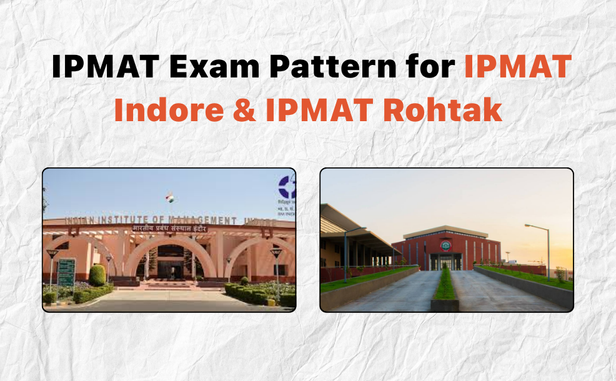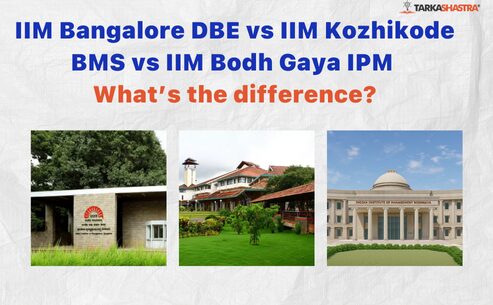The IPMAT (Integrated Programme in Management Aptitude Test) is one of the most sought-after entrance exams in India for students aspiring to join the prestigious five-year integrated management programs offered by top Indian Institutes of Management (IIMs). Two of the most popular and competitive IPMAT exams are conducted by IIM Indore and IIM Rohtak.
Every year, thousands of students from across the country prepare rigorously for IPMAT to secure admission into these coveted programs that combine undergraduate and postgraduate management education.
Understanding the exam pattern of IPMAT Indore and IPMAT Rohtak is crucial for aspirants because it directly impacts how you strategize your preparation, manage your time during the exam, and ultimately perform well.
This blog aims to provide you with a detailed and clear breakdown of the IPMAT 2026 exam patterns for both IIM Indore and IIM Rohtak. You will learn about:
- The number of sections and types of questions in each exam
- Time allocation for each section
- Marking scheme, including negative marking
- Key differences between the two exam patterns
Whether you are an aspirant, parent, or educator, this guide will help you grasp the essential structure of these exams and prepare effectively to ace the IPMAT 2026.
What is IPMAT?
The Integrated Programme in Management Aptitude Test (IPMAT) is an entrance exam designed specifically for students who have completed or are about to complete their 12th standard (or equivalent) and want to pursue a five-year integrated management program at top Indian Institutes of Management, such as IIM Indore and IIM Rohtak.
This integrated program combines undergraduate and postgraduate management education into a single, continuous curriculum. On successful completion, students earn both a bachelor’s degree and an MBA.
Why IPMAT?
- Early Start to Management Education: Unlike traditional MBA programs, IPMAT allows students to start their management journey immediately after class 12.
- Competitive Advantage: Getting into IIM Indore or Rohtak through IPMAT places candidates in a premium management program with industry recognition.
- Comprehensive Learning: The five-year curriculum includes foundational business concepts, practical exposure, internships, and advanced management subjects.
Target Candidates
- Students who are appearing for or have passed their 12th-grade board examinations.
- Candidates interested in a career in business management, leadership, and entrepreneurship.
- Those seeking a direct route to prestigious IIMs without the need for separate MBA entrance exams after graduation.
Importance of Understanding the Exam Pattern
Knowing the IPMAT exam pattern is the first step in crafting an effective study plan. The pattern reveals:
- The number and types of questions you will face
- The sectional time limits to help with time management
- Marking schemes and negative marking rules that affect accuracy and speed
With a clear understanding of these factors, aspirants can tailor their preparation to maximize performance in the actual exam.
Overview of IPMAT Indore and IPMAT Rohtak
The IPMAT exam is conducted by two premier Indian Institutes of Management — IIM Indore and IIM Rohtak. Both institutes offer a five-year integrated program in management. Still, there are important distinctions in their entrance exam patterns, structure, and focus areas.
Why Compare Both Exams?
- Aspirants often get confused about which exam to prioritize or apply for.
- Understanding the differences helps in planning targeted preparation.
- Some students appear for both exams, so knowing their patterns aids in effective time management.
Quick Comparison Table: IPMAT Indore vs IPMAT Rohtak
| Feature | IPMAT Indore | IPMAT Rohtak |
| Program Offered | 5-Year Integrated Programme in Management (IPM) | 5-Year Integrated Programme in Management (IPM) |
| Exam Sections | Quantitative Ability (Subjective + MCQ), Verbal Ability | Quantitative Ability, Logical Reasoning, Verbal Ability |
| Question Type | Mix of Subjective numeric and MCQs | All Multiple Choice Questions (MCQs) |
| Total Duration | 120 minutes (40 minutes per section) | 120 minutes (40 minutes per section) |
| Negative Marking | Only MCQs (−1 for wrong answers) | All MCQs (−1 for wrong answers) |
| Total Seats | Approximately 150 | Approximately 165 |
| Program Fee (Approx.) | ₹4-6 Lakhs per annum (varies by year) | ₹6+ Lakhs per annum |
Both exams test your aptitude in mathematics, verbal skills, and reasoning abilities, but the approach and pattern differ significantly.
In the following sections, we will dive deep into the exam patterns of IPMAT Indore and IPMAT Rohtak, respectively, so you can get a thorough understanding of each.
Detailed Exam Pattern of IPMAT Indore 2026
The IPMAT Indore exam is known for its unique structure that combines both subjective numeric answer type questions and multiple-choice questions (MCQs), making it slightly different from other management entrance exams.
Exam Structure
The exam consists of 3 sections, each allotted 40 minutes, making the total duration 120 minutes.
| Section | No. of Questions | Time Allotted | Type |
| Quantitative Ability (MCQs) | 30 | 40 minutes | Multiple Choice |
| Quantitative Ability (SA) | 15 | 40 minutes | Short Answer (No options) |
| Verbal Ability (MCQs) | 45 | 40 minutes | Multiple Choice |
| Total | 90 | 120 minutes | |
- The sequence of sections is randomized by the exam system and cannot be chosen by the candidate.
- The Quantitative Ability section is split into two parts: one subjective and one MCQ-based, testing numerical problem-solving and calculation skills.
- The Verbal Ability section evaluates English language proficiency through grammar, vocabulary, and reading comprehension questions.
Marking Scheme
| Question Type | Marks for Correct Answer | Negative Marking for Wrong Answer |
| Subjective Numeric | +4 marks | No negative marking |
| MCQs (Quantitative & Verbal) | +4 marks | −1 mark |
- Negative marking applies only to MCQ sections.
- No penalty for wrong answers in the numeric entry (subjective) section.
Section-wise Time Allocation
Each section has a strict 40-minute time limit, meaning time management is crucial to attempt all questions efficiently.
Question Types Explained
- Subjective Numeric Questions: These require candidates to calculate and enter the exact numerical answer without options. Accuracy and speed are critical here since there is no room for guessing.
- MCQs: Multiple-choice questions where candidates select the correct option from given choices.
- The split quantitative section tests both conceptual understanding and quick problem-solving skills.
This structure demands that aspirants are not only good at solving problems quickly but also precise in their answers, especially in the subjective section.
Detailed Exam Pattern of IPMAT Rohtak 2026
The IPMAT Rohtak exam has a straightforward and balanced structure with a strong emphasis on Logical Reasoning, which is absent as a separate section in IPMAT Indore.
Exam Structure
The exam comprises 3 sections, each with 40 minutes duration, totaling 120 minutes.
| Section | No. of Questions | Time Allotted | Type |
| Quantitative Ability | 40 | 40 minutes | Multiple Choice |
| Logical Reasoning | 40 | 40 minutes | Short Answer (No options) |
| Verbal Ability | 40 | 40 minutes | Multiple Choice |
| Total | 120 | 120 minutes | |
- All questions in IPMAT Rohtak are MCQs.
- Logical Reasoning forms a major part of the exam and tests critical thinking and problem-solving skills.
Marking Scheme
| Question Type | Marks for Correct Answer | Negative Marking for Wrong Answer |
| MCQs | +4 marks | −1 mark |
- Negative marking applies to all MCQs across all sections.
Section-wise Time Allocation
Each section has an allocated time of exactly 40 minutes, and candidates must manage their time effectively within each section.
Question Types Explained
- Quantitative Ability: Tests arithmetic, algebra, geometry, and basic data interpretation skills similar to Indore but excludes higher mathematics topics.
- Logical Reasoning: Includes puzzles, coding-decoding, blood relations, directions, syllogisms, and critical reasoning questions.
- Verbal Ability: Focuses on grammar, vocabulary, reading comprehension, and verbal reasoning.
The presence of a dedicated Logical Reasoning section in IPMAT Rohtak makes it a distinct choice for candidates who excel in reasoning and analytical thinking, while the exam’s MCQ-only format demands accuracy and speed.
Key Differences Between IPMAT Indore & IPMAT Rohtak Exam Patterns
Understanding the distinctions between the IPMAT Indore and IPMAT Rohtak exam patterns is vital for candidates planning their preparation strategies or deciding which exam(s) to attempt.
| Feature | IPMAT Indore | IPMAT Rohtak |
| Number of Sections | 3 | 3 |
| Section Names | Quantitative Ability (Subjective + MCQ), Verbal Ability | Quantitative Ability, Logical Reasoning, Verbal Ability |
| Question Types | Mix of Subjective numeric entry and MCQs | All MCQs |
| Total Number of Questions | 90 (15 subjective + 30 MCQ in Quant + 45 Verbal MCQs) | 120 (40 Quant + 40 LR + 40 Verbal) |
| Sectional Duration | 40 minutes each | 40 minutes each |
| Negative Marking | Only for MCQs (−1 per wrong answer) | For all MCQs (−1 per wrong answer) |
| Logical Reasoning Section | Not present | Separate 40-question section |
| Sequence of Sections | Randomized (not candidate’s choice) | Fixed order |
| Type of Quantitative Questions | Numeric entry (subjective) + MCQ | Only MCQs |
| Level of Difficulty | Higher focus on accuracy in numeric answers | Balanced across Quant, LR, Verbal |
| Total Marks | Varies by weighted scoring system | Calculated by total MCQ scores |
Summary of Differences
- Subjective vs MCQ: IPMAT Indore uniquely includes numeric answer-type questions requiring typed responses, whereas IPMAT Rohtak follows a fully MCQ format.
- Logical Reasoning: Rohtak has a dedicated Logical Reasoning section, while Indore incorporates reasoning only within verbal ability.
- Section Order: Indore’s exam sections appear in a randomized sequence, adding an element of unpredictability; Rohtak’s sections follow a fixed order.
- Negative Marking: Indore applies negative marking only for MCQs, giving some relief in the subjective section. Rohtak applies uniform negative markings to all questions.
This comparative clarity helps candidates tailor their preparation and exam strategy depending on the institute’s exam pattern they plan to target.
Importance of Understanding the Exam Pattern for Preparation
Grasping the detailed exam pattern of IPMAT Indore and Rohtak is a critical step that can significantly influence your preparation strategy and exam-day performance. Here’s why it matters:
1. Efficient Time Management
- Each section in both exams has a strict 40-minute time limit.
- Knowing the number and type of questions helps you allocate time wisely during practice and on exam day.
- For IPMAT Indore, managing time between subjective numeric and MCQ questions requires practice to avoid spending too long on any one type.
2. Tailored Study Plan
- IPMAT Indore’s mix of subjective and MCQs demands both conceptual clarity and accuracy in numerical answers.
- IPMAT Rohtak’s addition of a full Logical Reasoning section means you must dedicate significant time to reasoning practice.
- Understanding which sections carry more weight and their question types allows you to prioritize topics effectively.
3. Negative Marking Awareness
- Both exams apply negative markings but in different ways.
- Knowing that only MCQs attract penalties in Indore encourages careful answering in those sections. At the same time, you can be slightly more confident attempting numeric questions.
- In Rohtak, every wrong MCQ costs marks, so accuracy is paramount across all sections.
4. Practicing According to Question Types
- Indore’s subjective numeric section requires practice in typing precise answers without options — a skill different from selecting MCQs.
- Rohtak’s full MCQ pattern calls for quick decision-making and elimination skills.
- Logical Reasoning questions in Rohtak require focused practice to develop speed and accuracy.
5. Reducing Exam-Day Anxiety
- Familiarity with the exam format reduces surprises and helps build confidence.
- When you know what to expect, you can enter the exam hall with a calm mindset and a clear plan.
Tips to Use Exam Pattern Knowledge Effectively
| Preparation Aspect | How Exam Pattern Helps | Suggested Action |
| Time Allocation | Section-wise time limits guide pacing | Practice full-length timed mocks |
| Question Focus | Know question types to emphasize during study | Allocate time to numeric & reasoning practice |
| Negative Marking Strategy | Avoid guesswork in penalized sections | Develop accuracy; skip doubtful MCQs |
| Section Order Awareness | Prepare for random or fixed section sequences | Practice in different sequences for Indore |
| Mock Tests | Simulate real exam environment | Take section-wise and full tests |
By using the exam pattern as a foundation, your preparation becomes more focused, strategic, and effective — greatly improving your chances of success in IPMAT 2026.
Conclusion
Understanding the IPMAT Exam Pattern 2026 for both IIM Indore and IIM Rohtak is a critical foundation for effective preparation. While both exams test your aptitude in quantitative ability, verbal skills, and reasoning, their distinct patterns require tailored strategies:
- IPMAT Indore challenges you with a combination of subjective numeric entry and MCQ questions, demanding accuracy and precision alongside speed.
- IPMAT Rohtak follows a fully MCQ-based format with an added focus on logical reasoning, which tests your analytical and problem-solving skills extensively.
Both exams allow 40 minutes per section, emphasizing the importance of time management. Negative marking rules vary slightly, so a clear understanding helps you balance speed with accuracy.
By familiarizing yourself with these exam patterns, you can design a focused study plan, practice strategically, and reduce exam-day anxiety. Early and consistent preparation aligned with the specific pattern of your target exam will significantly improve your chances of securing admission into these prestigious programs.
For personalized guidance, expert coaching, and regular updates on IPMAT 2026, visit Tarkashastra—your trusted partner in cracking competitive management entrance exams.
Good luck with your IPMAT 2026 preparation!
Frequently Asked Questions (FAQs)
1. What Is The Total Duration Of The IPMAT Exam?
The total duration of the IPMAT exam for both IIM Indore and IIM Rohtak is 120 minutes (2 hours), divided into three sections of 40 minutes each.
2. How Many Sections Are There In IPMAT Indore And Rohtak?
Both exams have 3 sections. Indore’s sections are Quantitative Ability (Subjective + MCQ) and Verbal Ability. In contrast, Rohtak’s sections include Quantitative Ability, Logical Reasoning, and Verbal Ability.
3. Are The Sections In IPMAT Indore Fixed Or Randomized?
The section sequence in IPMAT Indore is randomized by the exam system. Candidates cannot choose the order in which sections appear.
4. Is There Negative Marking In Both IPMAT Indore And Rohtak?
Yes, but with differences:
- IPMAT Indore: Negative marking applies only to MCQ questions. No negative marking for subjective numeric questions.
- IPMAT Rohtak: Negative marking applies to all MCQ questions across all sections.
5. What Type Of Questions Are Asked In IPMAT Indore?
IPMAT Indore features a mix of subjective numeric entry questions (where you type answers) and multiple-choice questions (MCQs) in quantitative and verbal sections.
6. Does IPMAT Rohtak Have A Logical Reasoning Section?
Yes, IPMAT Rohtak includes a dedicated Logical Reasoning section with 40 MCQs, testing puzzles, coding-decoding, blood relations, and critical reasoning.
7. How Many Questions Are There In Each Section Of IPMAT Rohtak?
Each of the three sections in IPMAT Rohtak contains 40 questions, totaling 120 questions.
8. Are The Numeric Entry Questions In IPMAT Indore Difficult?
They require precision and clear conceptual understanding since answers must be typed exactly. The difficulty varies, but practicing accuracy and speed is crucial.
9. Can I Choose The Order Of Sections In IPMAT Indore?
No, the section order is pre-determined and randomized by the exam platform.
10. Is The Difficulty Level the Same For Both IPMAT Indore And Rohtak?
Both are competitive exams with comparable difficulty, but Indore’s numeric entry questions add an extra layer of challenge. At the same time, Rohtak’s Logical Reasoning section demands strong analytical skills.
11. How Important Is Accuracy Due To Negative Marking?
Accuracy is very important. Wrong MCQ answers attract a −1 mark, so guessing without confidence can reduce your overall score.
12. Are All Questions In IPMAT Rohtak Multiple Choice?
Yes, all questions in IPMAT Rohtak are MCQs.
13. What Are The Key Topics Covered In The Quantitative Section?
Topics include Arithmetic, Algebra, Geometry, Number Systems, Ratios, Percentages, Time-Speed-Distance, and Data Interpretation (more extensive in Rohtak).
14. Does IPMAT Indore Include Higher Mathematics Like Matrices And Logarithms?
Yes, IPMAT Indore’s quantitative syllabus includes some higher math topics like matrices, determinants, and logarithms, which are not present in Rohtak.
15. How Should I Prepare For The Logical Reasoning Section In IPMAT Rohtak?
Practice puzzles, coding-decoding, seating arrangements, blood relations, directions, and critical reasoning questions regularly to build speed and accuracy.
16. Is There Any Section That Does Not Have Negative Marking?
Yes, the subjective numeric section of IPMAT Indore does not have a negative marking.
17. What Is The Weightage Of Each Section In IPMAT Indore?
IPMAT Indore typically weights:
- Quantitative Ability MCQ – 25%
- Quantitative Ability Subjective – 25%
- Verbal Ability – 50%
- (weightage may vary slightly as per official guidelines)
18. Are Reading Comprehension Questions Included In The Verbal Section?
Yes, both IPMAT Indore and Rohtak include Reading Comprehension as an important component of the Verbal Ability section.
19. How Many Questions Do I Need To Attempt To Score Well?
Focus on accuracy and attempt as many questions as you can confidently solve within the time limit. Generally, attempting around 70-80% of questions correctly can fetch a good score.
20. Can I Appear For Both IPMAT Indore And IPMAT Rohtak In The Same Year?
Yes, aspirants are allowed to appear for both exams in the same year but need to register separately and prepare for the slight differences in patterns.







